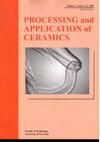Use of cobalt ferrite and activated carbon in supercapacitors
IF 0.8
4区 材料科学
Q3 MATERIALS SCIENCE, CERAMICS
引用次数: 0
Abstract
Supercapacitors are energy storage devices that can cleanly and efficiently meet the growing energy demand. The presentwork describes the synthesis of nanoparticles of cobalt ferrite (CoFe2O4) by the combustion method and their use with activated carbon (AC) to manufacture supercapacitors. In order to study the influence of composition on the electrochemical properties, supercapacitors with three different compositions were produced: Fe90 (90% CoFe2O4 and 10% AC), Fe50 (50% CoFe2O4 and 50% AC) and Fe10 (10% CoFe2O4 and 90% AC). Microstructural and morphological analyses were performed by X-ray diffraction (XRD), scanning electron microscopy (SEM), transmission electronmicroscopy (TEM), and Raman spectroscopy. Cyclic voltam-metry (CV), galvanostatic charge-discharge (GCD), floating and electrochemical impedance spectroscopy (EIS) tests were performed. XRD, SEM, TEM and Raman results showed that the combustion method was effective for the production of CoFe2O4 nanoparticles. SEM and Raman spectroscopy results showed that the AC has a porous structure and low crystallinity. According to CV, GCD and floating tests, all three supercapacitors presented excellent electrochemical stability. The Fe50 composition yielded the lowest equivalent series resistance, while the Fe10 composition yielded the highest capacitance. The results show that the combination of AC with CoFe2O4 is promising for the use in supercapacitors.钴铁氧体和活性炭在超级电容器中的应用
超级电容器是一种能够清洁高效地满足日益增长的能源需求的储能装置。本文介绍了用燃烧法制备纳米钴铁氧体(CoFe2O4)及其与活性炭(AC)结合制备超级电容器的方法。为了研究组成对电化学性能的影响,制备了三种不同组成的超级电容器:Fe90 (90% CoFe2O4和10% AC)、Fe50 (50% CoFe2O4和50% AC)和Fe10 (10% CoFe2O4和90% AC)。通过x射线衍射(XRD)、扫描电子显微镜(SEM)、透射电子显微镜(TEM)和拉曼光谱对样品进行了显微结构和形态分析。循环伏安法(CV)、恒流充放电法(GCD)、浮动阻抗法和电化学阻抗法(EIS)测试。XRD、SEM、TEM和Raman分析结果表明,燃烧法制备CoFe2O4纳米颗粒是有效的。SEM和拉曼光谱分析结果表明,活性炭具有多孔结构和低结晶度。通过CV、GCD和浮动测试,三种超级电容器均表现出优异的电化学稳定性。Fe50的等效串联电阻最低,而Fe10的等效串联电容最高。结果表明,交流与CoFe2O4的结合在超级电容器中具有广阔的应用前景。
本文章由计算机程序翻译,如有差异,请以英文原文为准。
求助全文
约1分钟内获得全文
求助全文
来源期刊

Processing and Application of Ceramics
MATERIALS SCIENCE, CERAMICS-
CiteScore
1.90
自引率
9.10%
发文量
14
审稿时长
10 weeks
期刊介绍:
Information not localized
 求助内容:
求助内容: 应助结果提醒方式:
应助结果提醒方式:


